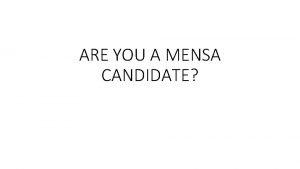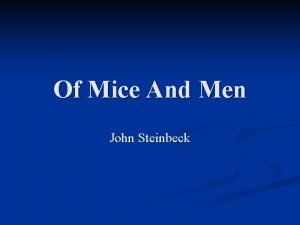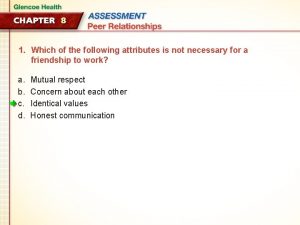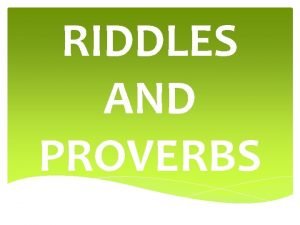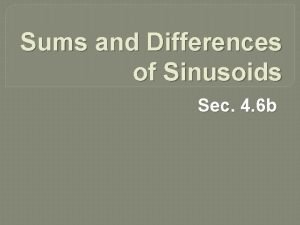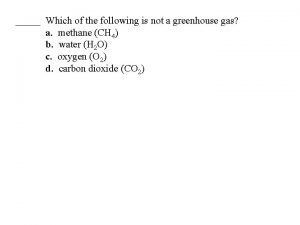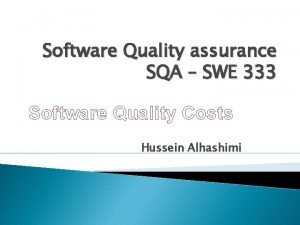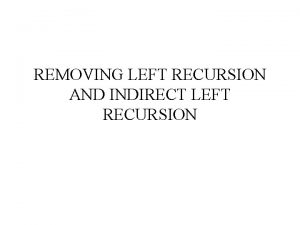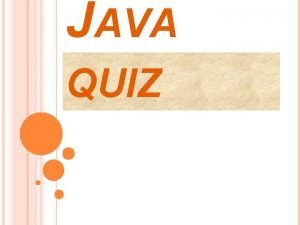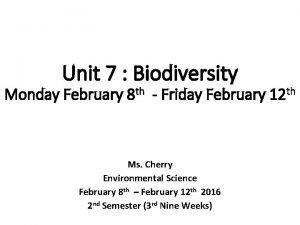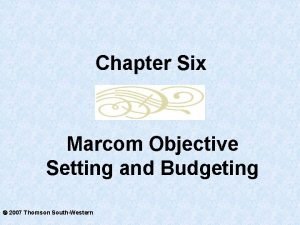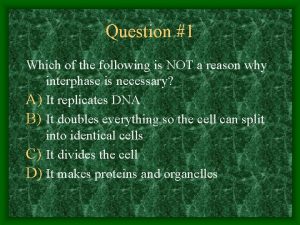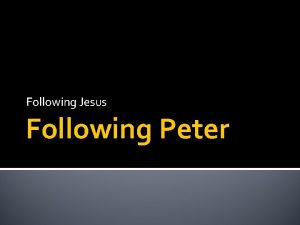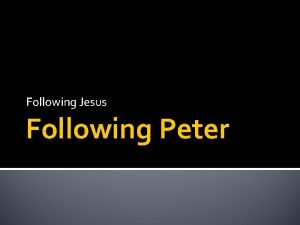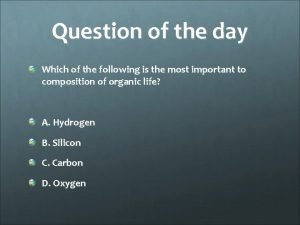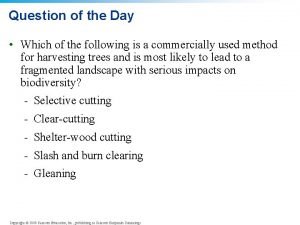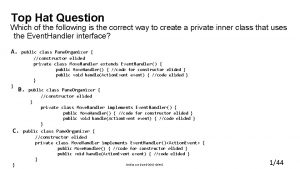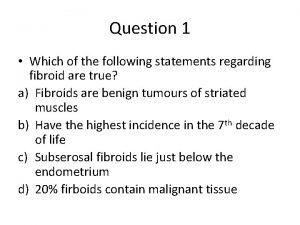Question 1 Which of the following is not











































- Slides: 43


Question 1 Which of the following is not a function of the plasma membrane? A. B. C. D. self-identification receptor site for messages selective barrier control center of the cell

Question 2 The structure in white blood cells associated with the enzymatic breakdown of foreign material is the: A. B. C. D. lysosome. Golgi apparatus. ribosome. centriole.

Question 3 Which of the following is a functional characteristic of ribosomes? A. B. C. D. manufacture of m. RNA protein synthesis DNA replication housing of DNA

Question 4 Which of the following is the first step of cellular respiration? A. glycolysis B. Kreb’s cycle C. ETC D. pyruvate oxidation

Question 5 What is the structure labeled #1? A. Carbohydrate chains B. Integral proteins C. Phospholipids D. Peripheral proteins E. Cholesterol

Question 6 What is the structure labeled #3? A. Carbohydrate chains B. Integral proteins C. Phospholipids D. Peripheral proteins E. Cholesterol

Question 7 ATP production occurs within which organelle? A. rough endoplasmic reticulum B. Golgi apparatus C. flagellum D. mitochondrion

Question 8 Preparation of protein molecules for cellular exportation is the function of which of the following organelles? A. B. C. D. Golgi apparatus smooth endoplasmic reticulum rough endoplasmic reticulum mitochondria

Question 9 In the egg lab which solution was hypertonic? A. Vinegar B. Distilled water C. Corn syrup

Question 10 The nucleolus is composed chiefly of: A. m. RNA. B. r. RNA. C. t. RNA. D. DNA.

Question 11 In the egg lab which solution was hypotonic? A. Vinegar B. Distilled water C. Corn syrup ?

Question 12 In the cell membrane, the hydrophilic part of the phospholipid molecule: A. faces the exterior of the cell. B. faces the interior of the cell. C. is in the center of the phospholipid bilayer. D. A and B.

Question 13 A. B. C. D. What are the organelles pictured in yellow? Intermediate filaments Desmosomes Integral proteins Centrioles ?

Question 14 A. B. C. D. The presence of this substance in the cell membrane keeps it from breaking too easily. cholesterol protein phospholipids glycoproteins

Question 15 A. B. C. D. The identification function of the cell membrane is carried out by the: cholesterol molecules. phospholipid molecules. glycoprotein molecules. channel proteins.

Question 16 Which of the following is function of the smooth endoplasmic reticulum. A. provide a site for ribosome attachment B. Store enzymes C. make lipids and store Ca D. Control what enters and exits the cell

Question 17 Cells placed in a hypertonic solution will ____? A. Swell B. Shrink C. Stay the same

Question 18 Which organelle is involved in protein synthesis. A. B. C. D. Rough ER Lysosomes Mitochondria Smooth ER

Question 19 The net gain of ATP from aerobic respiration is ____? A. 32 B. 2 C. 14 D. 36

Question 20 -25 Classify the following as active or passive transport. 20. Ion pump 21. Diffusion 22. Exocytosis 23. Pinocytosis 24. Facilitated diffusion 25. Bulk transport


Question 1 Which of the following is not a function of the plasma membrane? A. B. C. D. self-identification receptor site for messages selective barrier control center of the cell

Question 2 The structure in white blood cells associated with the enzymatic breakdown of foreign material is the: A. B. C. D. lysosome. Golgi apparatus. ribosome. centriole.

Question 3 Which of the following is a functional characteristic of ribosomes? A. B. C. D. manufacture of m. RNA protein synthesis DNA replication housing of DNA

Question 4 Which of the following is the first step of cellular respiration? A. glycolysis B. Kreb’s cycle C. ETC D. pyruvate oxidation

Question 5 What is the structure labeled #1? A. Carbohydrate chains B. Integral proteins C. Phospholipids D. Peripheral proteins E. Cholesterol

Question 6 What is the structure labeled #3? A. Carbohydrate chains B. Integral proteins C. Phospholipids D. Peripheral proteins E. Cholesterol

Question 7 ATP production occurs within which organelle? A. rough endoplasmic reticulum B. Golgi apparatus C. flagellum D. mitochondrion

Question 8 Preparation of protein molecules for cellular exportation is the function of which of the following organelles? A. B. C. D. Golgi apparatus smooth endoplasmic reticulum rough endoplasmic reticulum mitochondria

Question 9 In the egg lab which solution was hypertonic? A. Vinegar B. Distilled water C. Corn syrup

Question 10 The nucleolus is composed chiefly of: A. m. RNA. B. r. RNA. C. t. RNA. D. DNA.

Question 11 In the egg lab which solution was hypotonic? A. Vinegar B. Distilled water C. Corn syrup ?

Question 12 In the cell membrane, the hydrophilic part of the phospholipid molecule: A. faces the exterior of the cell. B. faces the interior of the cell. C. is in the center of the phospholipid bilayer. D. A and B.

Question 13 A. B. C. D. What are the organelles pictured in yellow? Intermediate filaments Desmosomes Integral proteins Centrioles ?

Question 14 A. B. C. D. The presence of this substance in the cell membrane keeps it from breaking too easily. cholesterol protein phospholipids glycoproteins

Question 15 A. B. C. D. The identification function of the cell membrane is carried out by the: cholesterol molecules. phospholipid molecules. glycoprotein molecules. channel proteins.

Question 16 Which of the following is function of the smooth endoplasmic reticulum. A. provide a site for ribosome attachment B. Store enzymes C. make lipids and store Ca D. Control what enters and exits the cell

Question 17 Cells placed in a hypertonic solution will ____? A. Swell B. Shrink C. Stay the same

Question 18 Which organelle is involved in protein synthesis. A. B. C. D. Rough ER Lysosomes Mitochondria Smooth ER

Question 19 The net gain of ATP from aerobic respiration is ____? A. 32 B. 2 C. 14 D. 36

Question 20 -25 Classify the following as active or passive transport. 20. Ion pump A 21. Diffusion P 22. Exocytosis A 23. Pinocytosis A 24. Facilitated diffusion P 24. Bulk transport A

What does the latin root “gloss -” stand for?
 Costa level questions examples
Costa level questions examples Uncontrolled, lacking in restraint
Uncontrolled, lacking in restraint What number should replace
What number should replace Why does carlson insist on shooting candy’s dog
Why does carlson insist on shooting candy’s dog Ability to use responsibility to override emotions
Ability to use responsibility to override emotions Riddle and proverbs
Riddle and proverbs Life of pi orange juice
Life of pi orange juice Locomotor movements list
Locomotor movements list Fact finding methods in system development
Fact finding methods in system development Which of the following functions is not a sinusoid?
Which of the following functions is not a sinusoid? Pl/sql supports data types) mcq
Pl/sql supports data types) mcq Throat paints are liquid preparations
Throat paints are liquid preparations What market form of meat does not undergo chilling
What market form of meat does not undergo chilling Which of the following is not a greenhouse gas?
Which of the following is not a greenhouse gas? Which of the following is not an appraisal cost in sqa?
Which of the following is not an appraisal cost in sqa? How to remove indirect left recursion
How to remove indirect left recursion Which of the following feature is not a keyword in java?
Which of the following feature is not a keyword in java? Which of the following is not part of overall biodiversity?
Which of the following is not part of overall biodiversity? Data mining functionalities with examples
Data mining functionalities with examples Which of the following is not a marcom budgeting method?
Which of the following is not a marcom budgeting method? Breeds of companion animals dogs assessment
Breeds of companion animals dogs assessment Which of the following is not an employability skill
Which of the following is not an employability skill Questions without question words
Questions without question words Closed questions
Closed questions Contoh open question
Contoh open question Factor isolating questions example
Factor isolating questions example Direct and indirect questions with answers
Direct and indirect questions with answers Supporting questions for a compelling question
Supporting questions for a compelling question Compelling question examples
Compelling question examples Hình ảnh bộ gõ cơ thể búng tay
Hình ảnh bộ gõ cơ thể búng tay Ng-html
Ng-html Bổ thể
Bổ thể Tỉ lệ cơ thể trẻ em
Tỉ lệ cơ thể trẻ em Voi kéo gỗ như thế nào
Voi kéo gỗ như thế nào Tư thế worm breton là gì
Tư thế worm breton là gì Bài hát chúa yêu trần thế alleluia
Bài hát chúa yêu trần thế alleluia Môn thể thao bắt đầu bằng từ chạy
Môn thể thao bắt đầu bằng từ chạy Thế nào là hệ số cao nhất
Thế nào là hệ số cao nhất Các châu lục và đại dương trên thế giới
Các châu lục và đại dương trên thế giới Công thức tiính động năng
Công thức tiính động năng Trời xanh đây là của chúng ta thể thơ
Trời xanh đây là của chúng ta thể thơ Mật thư anh em như thể tay chân
Mật thư anh em như thể tay chân 101012 bằng
101012 bằng Phản ứng thế ankan
Phản ứng thế ankan


